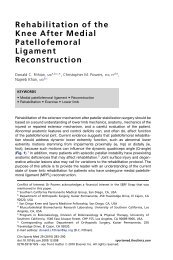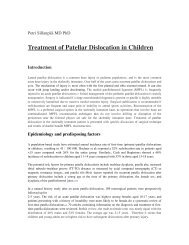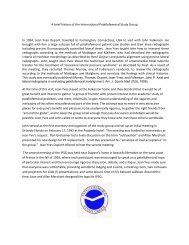NUMBERD2758dTHE J OURNAL OF B ONE &JOINT S URGERY JBJS. ORGd dVOLUME 90-A 12 ECEMBER 2008PATELLAR I NSTABILITYFig. 5Tibial tubercle realignment. A: A flat (no-angle) osteotomy allows medialization of the tibial tubercle. <strong>The</strong> elevator protects theneurovascular bundle. B: A steeper cut for equal anteriorization <strong>and</strong> medialization of the tibial tubercle. C: A very steep cut providesmaximum anteriorization of the tibial tubercle with less medialization. (Reprinted, with permission, from: Buuck DA, Fulkerson JP.Anteromedialization of the tibial tubercle: a 4- to 12-year follow-up. Op Tech Sports Med. 2000;8:136-7.)Carney et al. reviewed the results of the Elmslie-Trillatprocedure for the treatment of recurrent subluxation <strong>and</strong>dislocation of the patella in fifteen knees in fourteen patients 89 .<strong>The</strong> authors compared the outcomes at a mean of three yearswith those at a mean of twenty-six years <strong>and</strong> found no differencein instability between the two time-periods. Althoughnot significant, there was a trend toward a worsening Coxscore 90 with time, which occurred even though the articularcartilage was grossly intact.Koeter et al. reported the results of medial realignment ofthe tibial tubercle for patients with either painful lateral maltracking(with no instability) or patellar instability for longerthan one year <strong>and</strong> a tibial tubercle-trochlear groove distanceof >15 mm 86 . <strong>The</strong>re was no difference in the distance of themedial displacement between the groups. A mean of 5.7 mm ofdistalization of the tibial tubercle was achieved in nine patientswith lateral maltracking <strong>and</strong> twenty-two patients with patellarinstability. At two years postoperatively, although the patientswith patellar instability had more variable outcomes, bothgroups had improvement in all scores, with no significantdifference noted between the groups. Thus, the authors advocateda medial transfer, with or without distalization, for patientswith either patellar maltracking or patellar instability.Diks et al. found that a tibial tubercle transfer providedbetter results for patients with patellar maltracking <strong>and</strong> no instabilitythan for patients with isolated patellar instability 83 .Tibialtubercle transfer was performed in forty-three knees, twentysevenwith objective evidence of patellar instability <strong>and</strong> sixteenwith a laterally tracking patella. <strong>The</strong> mean duration of follow-upwas thirty-seven months. <strong>The</strong> transfers in the patients with patellarinstability were, overall, more effective in improving stability,doing so in 96% (twenty-six) of the twenty-seven patients,than they were in improving pain (63% of the patients). Onthe other h<strong>and</strong>, a higher percentage of patients (81%, thirteenof sixteen) with patellar maltracking had good pain relief.Barber <strong>and</strong> McGarry advocated the use of the modifiedElmslie-Trillat procedure for treatment of patellofemoral instabilitywithout evidence of arthritis 87 .<strong>The</strong>seauthorsperformeda medial translation of the tibial tubercle hinged on adistal periosteal flap along with an arthroscopic lateral retinacularrelease <strong>and</strong> medial capsular reefing for patients with atleast three recurrent patellar dislocations or subluxations thathad been resistant to a minimum of three months of physicaltherapy or bracing. Of thirty-five patients followed for a meanof ninety-eight months, 91% (thirty-two) had no additionalsubluxations or dislocations. Furthermore, there was improvementin the IKDC 65 ,Fulkersonknee 79 , <strong>and</strong> Lysholm <strong>and</strong>Gillquist 77 scores.Fulkerson et al. described anteromedialization of the tibialtubercle to address degenerative changes of the articular cartilage79 (Fig. 5). In a cadaver model of this procedure, pressure wasshown to be decreased on the lateral patellar facet at lowerangles of flexion (up to 30°) whereas pressure was equalizedbetween the medial <strong>and</strong> lateral patellar facets at greater angles offlexion 85 . <strong>The</strong>re was slight superior migration of the contact areaof the patellofemoral joint with distalization 85 . Cadaver studieshave also demonstrated that anteromedialization decreases thecontact pressures on the trochlear side overall, primarily on the
NUMBERD2759dTHE J OURNAL OF B ONE &JOINT S URGERY JBJS. ORGd dVOLUME 90-A 12 ECEMBER 2008PATELLAR I NSTABILITYTABLE I Grades of Recommendation for Summaries or Review ofOrthopaedic Surgical StudiesGradeABCIDescriptionGood evidence (Level-I studies with consistentfindings) for or against recommending intervention.Fair evidence (Level-II or III studies with consistentfindings) for or against recommending intervention.Poor-quality evidence (Level-IV or V studies withconsistent findings) for or against recommendingintervention.<strong>The</strong>re is insufficient or conflicting evidence notallowing a recommendation for or againstintervention.lateral <strong>and</strong> central areas of the trochlea 88 . However, pressures areelevated on the medial aspect of the trochlea <strong>and</strong> the proximalmedialaspect of the patella at all flexion angles, <strong>and</strong> thus cautionshould be used when performing an anteromedialization procedurein patients with medial-sided defects 88 .Buuck <strong>and</strong> Fulkerson reviewed their results with anteromedializationat an average of 8.2 years postoperatively 81 .<strong>The</strong>ir indications for the procedure were painful patellofemoralmaltracking (subluxation or tilt) with degenerativechanges on the distal <strong>and</strong> lateral aspects of the patella. Poorerresults were associated with Outerbridge 91 grade-3 or 4 lesionsin the central or medial aspects of the trochlea. Notably, threeof the six fair or poor results were in patients who had compensationclaims or were involved in litigation. Overall, 74%(thirty-one) of the forty-two patients had a good or excellentresult at an average of 8.2 years postoperatively.Pritsch et al. reported their results of tibial tubercle transferfor treatment of recurrent patellar instability, anterior knee pain,<strong>and</strong> evidence of maltracking on a dynamic computed tomographyscan 85 . Sixty-nine knees followed for a median of 6.2 yearshad a significant improvement between the preoperative <strong>and</strong>postoperative Lysholm <strong>and</strong> Gillquist 77 <strong>and</strong> Karlsson 92 score categoriesof instability, pain, <strong>and</strong> stair-climbing (p < 0.001).However, patients who had had only instability preoperativelydid better than patients with pain or both pain <strong>and</strong> instabilitypreoperatively. A better outcome was correlated with male sex,intact patellar articular cartilage, <strong>and</strong> symptoms of patellar instability.Physical examination findings that correlated with aworse prognosis included a positive patellar grind test, retinacularpain, a positive patellar tilt test, <strong>and</strong> a positive J-sign. <strong>The</strong>duration of follow-up was also positively correlated with betterLysholm <strong>and</strong> Gillquist 77 <strong>and</strong> Karlsson 92 scores, which the authorsattributed to the need for quadriceps recovery in the short term.Furthermore, there was no deterioration of the results with time.Pidoriano et al. found that the location of articular cartilagedamage in the patellofemoral joint correlated with the outcomeafter anteromedialization 80 . Of thirty-six patients (thirty-sevenknees), 56% (twenty) had the procedure performed because ofpatellar instability. All twenty-three patients with distal <strong>and</strong>lateral patellar lesions were extremely satisfied with the result ofthe procedure. <strong>The</strong>re was a 95% rate of good-to-excellent results(if no Workers’ Compensation claim was involved), <strong>and</strong> 87%had good-to-excellent pain relief. <strong>The</strong> authors recommendednot proceeding with the operation if medial, proximal, or diffuselesions were present on the patella or if central lesions werepresent on the trochlea. Interestingly, the Outerbridge 91 classificationof the lesion had no effect on the outcome.Palmer et al. also reported satisfactory results after anteromedializationfor treatment of both instability <strong>and</strong> painfulpatellar maltracking 84 . In a study of eighty-four patients followedfor a mean of 5.6 years, the result was good to excellent in 80% ofpatients with dislocation <strong>and</strong> 71% of patients with pain frommaltracking. <strong>The</strong>re was no significant difference in outcomebetween the groups, leading the authors to recommend anteromedializationof the tibial tubercle with distalization as aneffective procedure for both instability <strong>and</strong> pain due to maltracking.Predictors of poor postoperative results were postoperativeanterior knee pain <strong>and</strong> a previous realignment procedure.Fracture of the proximal part of the tibia or of the tibialtubercle after tibial tubercle transfer has been reported by severalauthors 86,93,94 . All cases occurred within three months after theoperation <strong>and</strong> were attributed to early weight-bearing. Suggestedpreventive measures have included avoidance of step cuts 86 ,anosteotomy of at least 5 cm in length <strong>and</strong> 0.75 cm in thickness toavoid fracture of the tuberosity 86 , protected weight-bearing oversix to eight weeks in a hinged knee brace, <strong>and</strong> advancement tofull weight-bearing once the osteotomy site is fully healed 93-95 .Overview<strong>The</strong> evaluation <strong>and</strong> treatment of patellar instability continue toevolve. <strong>The</strong> importance of a thorough physical examination <strong>and</strong>an accurate diagnosis cannot be stressed enough. We typicallyTABLE II Grades of Recommendation for the Treatment of Acute <strong>Patellar</strong> Dislocation <strong>and</strong> Chronic <strong>Patellar</strong> <strong>Instability</strong> with Associated FactorsDisorder Treatment Grade of RecommendationAcute patellar dislocation Early medial-sided repair or nonoperative treatment AChronic patellar instability with associated factorsPatella alta Tibial tubercle realignment CMedial patellofemoral ligament injury Medial patellofemoral ligament reconstruction CTrochlear dysplasia Trochleoplasty CElevated tibial tubercle-to-trochlear groove distance Tibial tubercle realignment C






